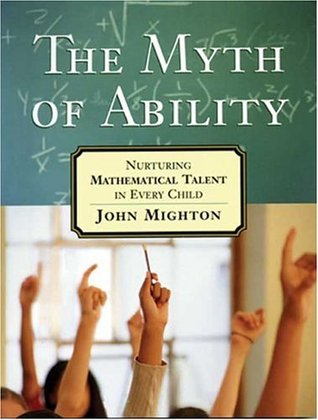It's a dreich day here in Aberdeen. The dogs need to go out for a walk (our two dogs, plus two dogs belonging to friends who are currently sunning themselves in the States), but they are all looking at me disbelievingly when I suggest it next to an open door, so we are putting it off for awhile, in hopes that the rain will stop soon!
So I thought I'd write a bit more about The Myth of Ability, and the JUMP approach to teaching maths (I'm going to use the Scottish 'maths', rather than the American 'math', since I'm currently living and teaching in Scotland. For the record, though, saying 'maths' still sounds slightly odd to my ears!).
Mighton strongly advocates for teaching children at the same level, and he insists in his books that, given appropriate instruction and scaffolding, we can close the achievement gap between our most and least able maths students. He extends the learning of students who finish more quickly by giving them 'bonus' questions to work on. I've used this before in my class - bonus questions allow your 'fast finishers' to continue working with the same concept that has just been taught, but they apply it to larger numbers or slightly trickier problems. In many contexts, I've found this to be very effective. Never underestimate how motivating it can be for a child to be working with 'big numbers'!
Here's a video where John Mighton talks about the JUMP Math programme. Then teachers and students who have taught and learned with JUMP Math talk about their experiences. I guess one of my biggest take-aways from JUMP math is simply the idea that when a child isn't understanding a concept, I need to re-look at how I am teaching it. How can I break the idea down more or differently? Some children will always grasp ideas more quickly or slowly - but I really like the JUMP outlook: let's not give up on any child. As a teacher, it's much more productive for me to re-look at my own practice and how I am explaining or making space for practicing a mathematical concept.
So I thought I'd write a bit more about The Myth of Ability, and the JUMP approach to teaching maths (I'm going to use the Scottish 'maths', rather than the American 'math', since I'm currently living and teaching in Scotland. For the record, though, saying 'maths' still sounds slightly odd to my ears!).
Mighton strongly advocates for teaching children at the same level, and he insists in his books that, given appropriate instruction and scaffolding, we can close the achievement gap between our most and least able maths students. He extends the learning of students who finish more quickly by giving them 'bonus' questions to work on. I've used this before in my class - bonus questions allow your 'fast finishers' to continue working with the same concept that has just been taught, but they apply it to larger numbers or slightly trickier problems. In many contexts, I've found this to be very effective. Never underestimate how motivating it can be for a child to be working with 'big numbers'!
Here's a video where John Mighton talks about the JUMP Math programme. Then teachers and students who have taught and learned with JUMP Math talk about their experiences. I guess one of my biggest take-aways from JUMP math is simply the idea that when a child isn't understanding a concept, I need to re-look at how I am teaching it. How can I break the idea down more or differently? Some children will always grasp ideas more quickly or slowly - but I really like the JUMP outlook: let's not give up on any child. As a teacher, it's much more productive for me to re-look at my own practice and how I am explaining or making space for practicing a mathematical concept.


 RSS Feed
RSS Feed